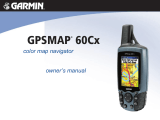
NOTE: Using the Most Often interval provides the most
track detail, but fills up the device memory quicker.
• If you selected Distance or Time for the Record Method,
enter a value, and select .
Navigating Using TracBack
®
While navigating, you can navigate back to the beginning of
your track. This can be helpful when finding your way back to
camp or the trail head.
1
Select Track Manager > Current Track > > TracBack.
The map displays your route with a magenta line, start point,
and end point.
2
Navigate using the map or the compass.
Stopping Navigation
From the map or compass, select > Stop Navigation.
Navigating to a Destination
1
Select Where To?.
2
Select a category.
3
Select a destination.
4
Select Go.
The map opens with your route marked with a magenta line.
5
Navigate using the map (page 4) or compass (page 4).
Navigating with the Map
1
Begin navigating to a destination (page 4).
2
Select Map.
A blue triangle represents your location on the map. As you
travel, the blue triangle moves and leaves a track log (trail).
You can change how the track log appears on the map
(page 3).
3
Complete one or more actions:
• Drag the map to view different areas.
• Select and to zoom in and out of the map.
• Select a location on the map (represented by a pin), and
select the information bar at the top of the screen to view
information about the selected location.
Navigating with the Compass
When navigating to a destination, points to your destination,
regardless of the direction you are moving.
1
Begin navigating to a destination (page 4).
2
Select Compass.
3
Turn until points toward the top of the compass, and
continue moving in that direction to the destination.
Camera and Photos
You can take photos with the Oregon 650 and 650t. When you
take a photo, the geographic location is automatically saved in
the photo information. You can navigate to the location.
Taking a Photo
1
Select Camera.
2
Turn the device horizontally or vertically to change the
orientation of the photo.
3
If necessary, select to turn on the flash.
You can select Auto to use the flash only when the camera
detects a low light scene.
4
If necessary, use two fingers on the touchscreen to zoom in
or out (page 3).
5
Hold to focus and hold the device still.
A white frame appears on the screen. The device focuses on
the object inside of the frame. When the photo is in focus,
the frame turns green.
6
Release to take a photo.
Downloading Geocaches
1
Connect your device to a computer using the USB cable.
2
Go to www.opencaching.com.
3
If necessary, create an account.
4
Sign in.
5
Follow the on-screen instructions to find and download
geocaches to your device.
Customizing the Device
Adjusting the Backlight Brightness
Extensive use of screen backlighting can significantly reduce
battery life. You can adjust the backlight brightness to maximize
the battery life.
NOTE: The backlight brightness may be limited when the
battery is low.
1
Select .
2
Use the slider to adjust the backlight level.
The device may feel warm when the backlight setting is high.
Customizing the Main Menu
• Hold any icon on the main menu or application drawer, and
drag it to a new location.
• Open the application drawer, and drag an icon up to the
main menu.
• Select Setup > Main Menu, and follow the on-screen
instructions.
Locking the Touchscreen
You can lock the screen to prevent inadvertent screen touches.
Select > .
Unlocking the Touchscreen
Select > .
Rotating the Screen
Rotate your device to view in horizontal (landscape) or
vertical (portrait) mode.
Profiles
Profiles are a collection of settings that optimize your device
based on how you are using it. For example, the settings and
views are different when you use the device for hunting than
when geocaching.
When you are using a profile and you change settings, such as
data fields or units of measurement, the changes are saved
automatically as part of the profile.
Selecting a Profile
When you change activities, you can change the setup of the
device by changing the profile.
4






